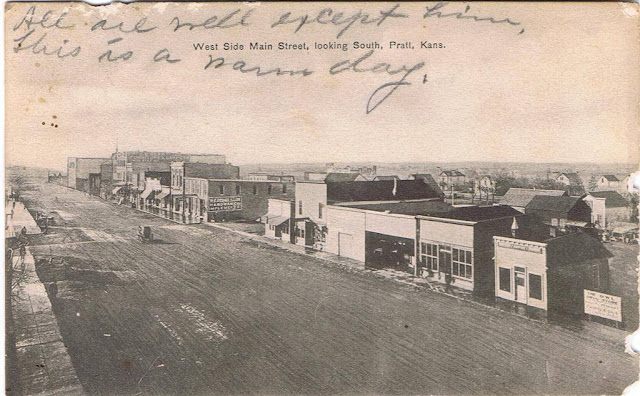 |
When they reached Pratt, crowds had already begun to gather, and the three men lingered among those preparing the B-B-Q for the next day's dinner. Isaac had not had his photograph taken in 15 years, so he headed to Logan's Studio for a portrait.
The People's Party Convention had been held July 15, 1890, and there was great enthusiasm for the slate of men chosen. While Isaac was in town on the 17th, following the convention, he had met amateur photographer Seth Blake, and they had quickly developed a friendship. Isaac helped Seth build a dark tent out of layers of calico, and they decided to photograph People's Party rallies, documenting what they believed was an important time in American history.
Could the photograph above have been taken on November 1, 1890?
 |
| West Side Main Street, looking South, Pratt, KS |
 |
| Briggs House, built 1887 on the SW corner south of the current Barron Theater |
Look at the two pictures above. The Briggs House appears to be the structure that the band has just passed, and it is on the proper corner that a parade headed to the south would have passed. This photograph was collected by Judge Renner and shared by his son Chuck, who also provided its date of construction as 1887. Our knowledgeable local historian, Marsha Brown, has indicated that the building was located on the corner just south of the historic Barron Theater. Therefore, the People's Party parade could have passed by that building in 1890.
 |
| Business built in 1887 |
According to another Pratt historian, Rodney Smith, who provided the picture of the building at left, it was also built in 1887, and if you look closely at the photograph of the left side of Main Street, you can see the pediment holding a lightning rod atop that building.
This business building later became the 1st National Bank. Isaac wrote in his journal about the 1st National Bank, but I am not certain of its location in 1890, prior to occupying this building.
If you return to the top of the page to look at the picture of the parade, you can see a band behind the lone rider. St. John, Kansas had a brass band, and they frequently were mentioned in newspapers as participating in People's Party parades and rallies.
Isaac B. Werner wrote in his journal that the parade passed by him headed south on Main Street, that it was a mile long and took 3/4th of an hour to pass by him, and that he estimated a crowd of 8,000 to 9,000 people. Werner, Blake, and Petefist took 30 exposures on three different cameras. The Pratt County Register estimated the number of people in the procession at 5,000 with 800 vehicles.
There are clues to support the possibility that the image at the top of the blog could have been taken on November 1, 1890 of the People's Party parade that Isaac Werner attended. The American Flag and the word "Victory" might indicate a political parade, or perhaps a 4th of July celebration. If you look closely, however, there are vehicles in the picture. Are they buggies or early motor cars? They may offer the best solution in determining the date of the photograph.
I hope to hear from some of you sharp-eyed historians with help in deciphering when the photograph of the parade might have been taken. Although it may not be a photograph of the 1890 People's Party parade, it certainly gives a hint of what Isaac would have seen.
No comments:
Post a Comment